Embark on a captivating exploration of the Bigender Flag, a dynamic symbol that goes beyond its vibrant hues to represent the multifaceted experiences within the bigender community. In this journey, we’ll uncover the significance of each color, admire the intentional design, and delve into the profound symbolism woven into this flag.
Join us in recognizing and celebrating the diverse spectrum of dual gender identities, embracing the inclusive essence that defines the rich tapestry of the bigender community.
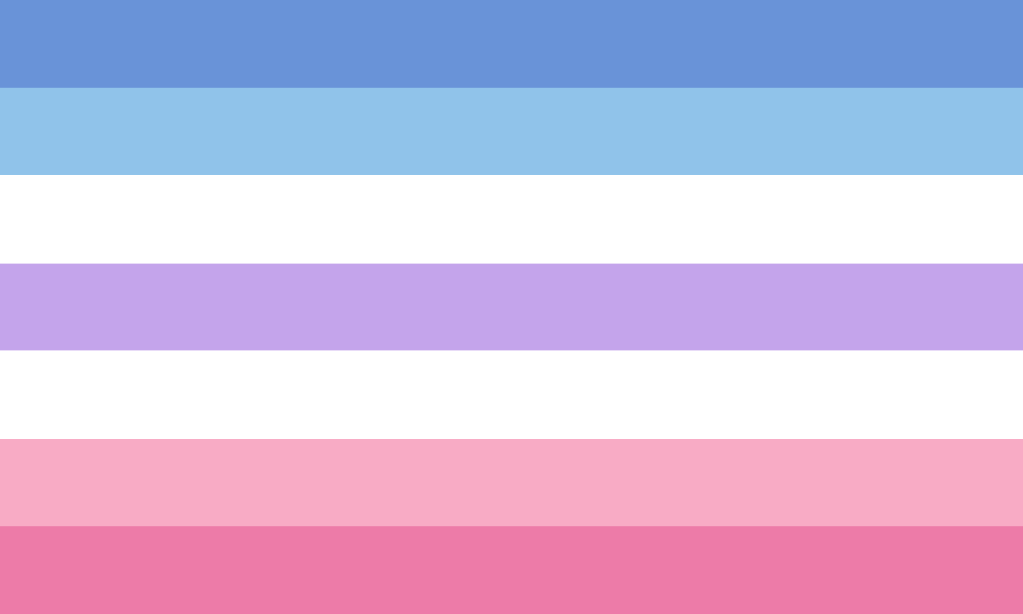
Download the Bigender Flag as a HR PNG or SVG.
Meaning and Symbolism
The Bigender flag is a powerful symbol within the LGBTQ+ community, representing individuals who identify as bigender—experiencing two gender identities either simultaneously or at different times. This vibrant flag is an emblem of inclusivity, celebrating the diversity of gender experiences beyond the binary. Its colors hold significant meaning, embodying the essence of bigender identity.
The flag’s palette is a visual testament to the spectrum of gender. The top stripe, a gentle pink, signifies femininity, while the bottom stripe, a calming blue, represents masculinity. Between them lies a blending of these hues, showcasing the fluidity that characterizes the bigender experience. The lavender stripe captures the nuances of non-binary identities within the bigender spectrum.
In the rich tapestry of the LGBTQ+ community, the Bigender flag contributes to a broader narrative of visibility and pride. It stands alongside other pride flags, collectively waving as symbols of unity and acceptance. During pride parades and awareness campaigns, the Bigender flag proudly unfurls, fostering awareness of the diverse identities that form the LGBTQ+ mosaic.
Moreover, the flag is not just a colorful banner; it’s an emblem of activism and advocacy. It serves as a rallying point for the bisexual community and allies, promoting equality and pushing for LGBTQ+ rights. The symbolism encapsulated in the flag resonates deeply during Pride Month, a time dedicated to celebrating and affirming the identities that enrich the LGBTQ+ community.
In using the Bigender flag as a symbol, individuals find strength in representation, forging connections within the community and raising awareness about the diverse array of gender identities. It stands as a reminder that love, acceptance, and equality transcend rigid societal norms, and everyone has the right to be proud of their authentic selves.

History of the Bigender Flag
The history of the Bigender flag is a journey marked by the quest for visibility and representation within the LGBTQ+ community. The term “bigender” itself has early roots, dating back to the late 1980s when it was initially grouped under the label “bigenderist” within the broader category of “androgyne.” The term was defined as expressing “either gender role” or as “having two genders.”
As understanding and discourse around gender identities evolved, the need for distinct symbols and flags arose. The Bigender flag, with its unique combination of colors, was created to provide a visual representation for individuals who identify as bigender—experiencing two gender identities. The flag’s colors carry specific meanings, reflecting the nuances of the bigender experience.
However, the journey of the Bigender flag has not been without challenges. The original flag faced controversy due to revelations about its creator, leading to discomfort within the community. In response, alternative designs emerged, reflecting the community’s resilience and commitment to inclusivity.
The evolution of the Bigender flag is intertwined with the broader history of LGBTQ+ rights and activism. It serves as a symbol not only of individual identity but also as a collective representation of the diverse gender spectrum. During LGBTQ+ history milestones and events, the Bigender flag has been proudly displayed, contributing to the rich tapestry of symbols that advocate for equality and acceptance.
Understanding the history of the Bigender flag is a testament to the continuous evolution of language, identity, and the ongoing pursuit of visibility within the LGBTQ+ community. Each color, stripe, and design choice tells a story of resilience, community, and the celebration of diverse gender experiences.

Colors and Their Representation
- Blue: This bold and vibrant color stands at one end of the Bigender flag, symbolizing the masculine aspect of the bigender identity. It proudly represents the spectrum of gender identities that encompass a sense of masculinity within the bigender experience.
- Light Blue: Adjacent to the deep blue, the light blue stripe signifies the fluidity inherent in bigender identity. It captures the nuanced blending between different gender identities, illustrating the dynamic nature of simultaneously or alternately experiencing two genders.
- White (between light blue and lavender): Positioned between the light blue and lavender stripes, the white space emphasizes inclusivity. It serves as a neutral zone, representing non-binary gender identities and acknowledging that bigender experiences extend beyond the traditional binary of male and female.
- Lavender (light purple): The introduction of lavender adds a layer of representation for non-binary gender identities within the bigender spectrum. This light purple stripe highlights the diversity of gender experiences and fosters an inclusive understanding of gender.
- White (between lavender and light pink): Another white stripe, strategically placed between lavender and light pink, serves as a visual reminder of the neutral ground. It reinforces the idea of inclusivity, creating space for the various gender identities that fall within the bigender spectrum.
- Light Pink: This delicate hue signifies femininity on the Bigender flag. It recognizes and celebrates the feminine aspect of the bigender identity, acknowledging the presence of diverse gender expressions within this identity.
- Pink: Completing the flag, the pink stripe stands at the opposite end from blue, symbolizing the feminine aspect of the bigender identity. Together, the blue and pink bookends represent the broad range of gender experiences encapsulated within the bigender identity.
These carefully chosen colors collectively form the Bigender flag, a vibrant and meaningful symbol that communicates the rich diversity and complexity of bigender identity.

What are the RAL or Pantone colors of the Bigender Flag?
The Bigender Flag doesn’t have official Pantone or RAL specifications, the following approximations can be used:

BLUE
Pantone: 279 C
RAL: 5015
HEX: #6993d8

LIGHT BLUE
Pantone: 284 C
RAL: 5012
HEX: #90c3ea

WHITE
Pantone: White
RAL: 9010
HEX: #FFFFFF

LAVENDER
Pantone: Violet 0631 C
RAL: 4005
HEX: #c3a3ea

LIGHT PINK
Pantone: 1767 C
RAL: 3015
HEX: #f8abc5

PINK
Pantone: 204 C
RAL: 4003
HEX: #ed7ba8
Kindly be aware that the colors mentioned here are approximations, and the exact shades may vary based on factors such as the production method, material, and lighting conditions. For accurate color representation, it is advisable to utilize physical color samples or seek guidance from a professional color-matching service.

Usage and Recognition
The Bigender flag serves as a powerful emblem of visibility, recognition, and community within the LGBTQ+ spectrum. Its distinctive colors and symbolism have found resonance in various contexts, contributing to the broader conversation surrounding gender identity.
In LGBTQ+ pride events and parades, the Bigender flag waves proudly alongside other pride flags, representing the unique experiences of individuals who identify as bigender. Its presence fosters a sense of community, providing a visual affirmation that diverse gender identities are an integral part of the LGBTQ+ tapestry.
The usage of the Bigender flag extends beyond physical manifestations in pride events; it has become a vital digital symbol, shared across social media platforms and online spaces. This virtual visibility is instrumental in raising awareness about bigender identity on a global scale. Individuals proudly incorporate the flag into their online profiles, fostering a sense of connection and solidarity within the digital LGBTQ+ community.
Recognition of the Bigender flag is not confined to LGBTQ+ circles alone. It plays a crucial role in broader conversations about gender diversity and inclusivity. As society becomes more aware of the spectrum of gender identities, the Bigender flag stands as a visual cue, prompting discussions about the complexity and fluidity of gender experiences.
In educational settings, workplaces, and public spaces, the display of the Bigender flag contributes to a more inclusive environment. It prompts conversations about gender diversity, challenging preconceived notions and fostering understanding. The flag’s symbolism has the power to create a safer and more welcoming space for individuals who identify as bigender.
Moreover, the usage of the Bigender flag aligns with advocacy efforts for LGBTQ+ rights and social justice. As the flag becomes more widely recognized, it becomes a symbol of the ongoing struggle for equality, representation, and acceptance for all gender identities. In this way, the Bigender flag transcends its physical representation, becoming a catalyst for positive change and increased visibility for the bigender community on a global scale.
Related Flags and Symbols:

Rainbow Flag: The universally recognized LGBTQ+ Pride flag, featuring a spectrum of colors, designed by Gilbert Baker.

Transgender Pride Flag: Designed by transgender activist and Navy veteran Monica Helms, it consists of light blue, pink, and white stripes, representing the transgender community.
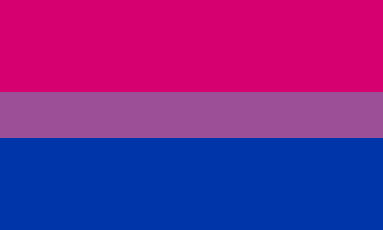
Bisexual Pride Flag: Created by Michael Page, it features three horizontal stripes—pink, purple, and blue—symbolizing attraction to more than one gender.

Non-Binary Pride Flag: Created by Kye Rowan, it features yellow, white, purple, and black stripes, symbolizing genders outside the traditional binary.

Genderqueer Pride Flag: Designed by Marilyn Roxie, it features lavender, white, and dark green stripes, representing genderqueer, non-binary, and genderfluid identities.
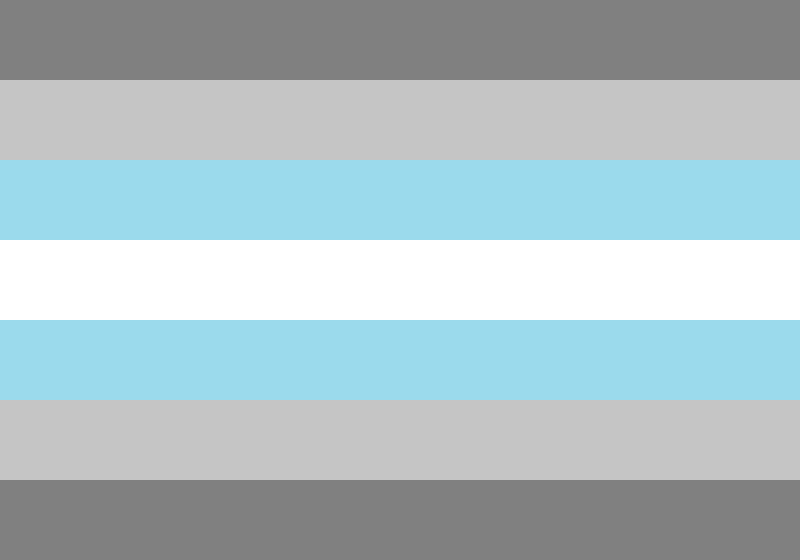
Demiboy Pride Flag: Designed by an anonymous Tumblr user, it consists of light blue, white, and black stripes, representing a partial connection to being male.

Demigirl Pride Flag: Also designed by an anonymous Tumblr user, it features light pink, white, and black stripes, representing a partial connection to being female.
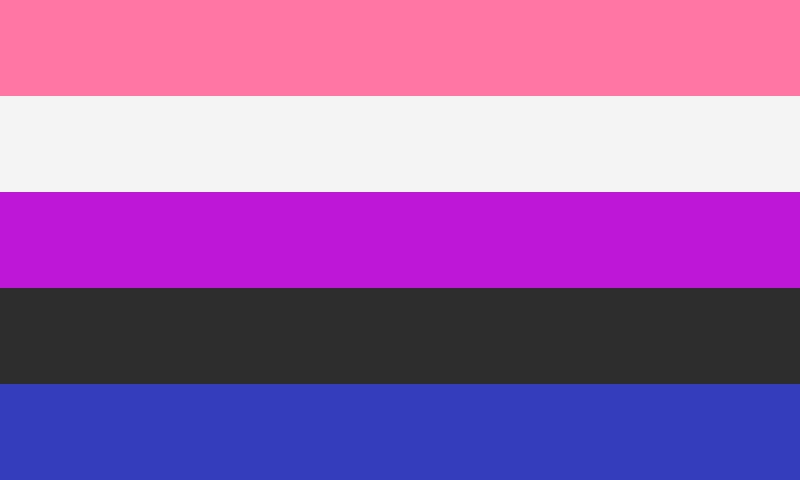
The Genderfluid Flag: designed in 2012 by activist JJ Poole, is a vibrant emblem symbolizing the diverse spectrum of gender identities, with each carefully chosen color representing different facets of the genderfluid experience.

The Omnisexual Flag: Omnisexuality involves attraction to all genders, with preferences varying. Created in 2015, the Omnisexual Pride Flag represents the gender spectrum with light pink and blue for femininity and masculinity, and dark purple for those outside traditional categories..
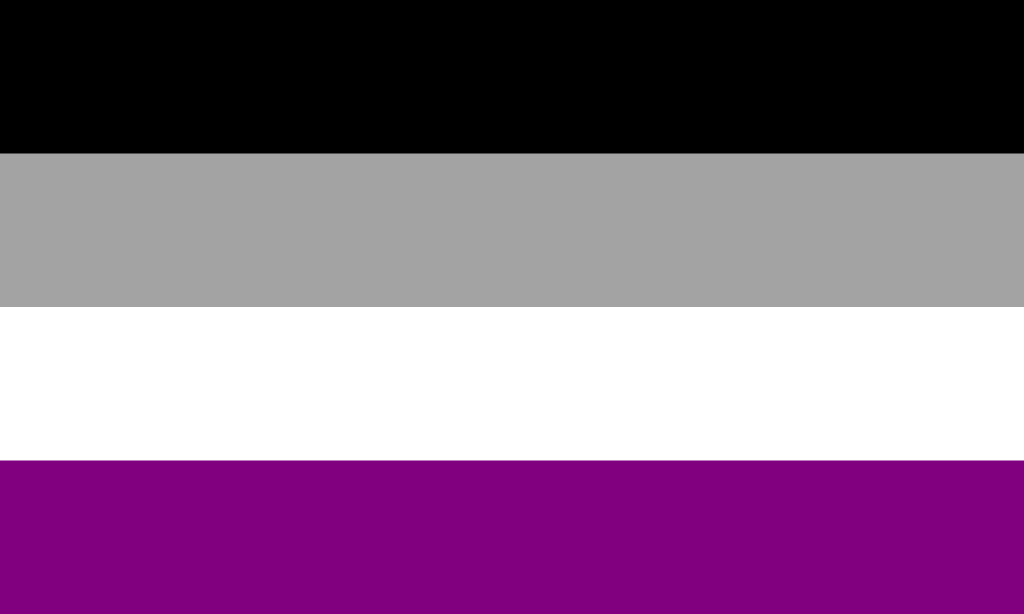
The Asexual Pride Flag:
Crafted in 2010 by StandUp of AVEN, the Asexual Pride Flag symbolizes the asexual community with its four horizontal stripes: black for asexuality, gray for the spectrum, white for sexuality, and purple for diversity. Read more.

The Pansexual Pride Flag:
The 2010 Pansexual Pride Flag, featuring three horizontal stripes representing attraction to females, males, and all genders (pink, blue, and yellow, respectively), stands as a vibrant symbol of the inclusive nature of pansexuality at LGBTQ+ events and online platforms. Read more.

Bigender Community Acceptance and Adoption
The acceptance and adoption of the Bigender flag within the broader LGBTQ+ community signify a significant step towards fostering inclusivity and understanding of diverse gender identities. As conversations around gender continue to evolve, the Bigender flag has found a home as a symbol of recognition and respect for those who identify as bigender.
Within LGBTQ+ spaces, the Bigender flag has been embraced as a tangible representation of the diverse gender spectrum. Its adoption during pride events, gatherings, and social media platforms demonstrates a collective commitment to acknowledging the unique experiences of bigender individuals. The flag has become an emblem of unity, signaling that the LGBTQ+ community is a space where all gender identities are not only accepted but celebrated.
The growing acceptance of the Bigender flag is reflective of a broader cultural shift toward recognizing the complexity of gender identities. As more individuals share their experiences and proudly identify as bigender, the flag serves as a unifying symbol, reinforcing the importance of embracing diversity within the LGBTQ+ community.
Educational initiatives and awareness campaigns have played a crucial role in fostering acceptance of the Bigender flag. By providing information about the meaning and significance of the flag, these efforts contribute to a more informed and inclusive society. The flag’s adoption in educational settings further encourages dialogue, challenging stereotypes, and promoting an environment where all gender identities are respected.
In essence, the acceptance and adoption of the Bigender flag represent a positive trajectory toward a more inclusive and affirming world for those who identify as bigender. As this symbol gains prominence, it contributes to the ongoing journey of creating spaces where everyone, regardless of their gender identity, can find acceptance, support, and a sense of belonging.
What does it mean to be Bigender?
Being bigender means that an individual identifies with two distinct gender identities, either simultaneously or at different times. These gender identities may include but are not limited to, the traditional binary categories of male and female. Bigender individuals experience a sense of duality or fluidity in their gender expression, and their identity may shift between these two genders.
It’s important to note that bigender is a term within the broader spectrum of gender identities, and individuals who identify as bigender may express their gender in various ways. Some bigender people may feel both genders strongly and consistently, while others may experience shifts in their gender identity over time or in different situations.
Being bigender is a personal and individual experience, and it is essential to respect each person’s self-identification and expression. The term reflects the diversity and complexity of gender experiences beyond the binary, contributing to a more nuanced understanding of gender within the LGBTQ+ community and society at large.
Individuals who identify as bigender may choose to express their gender identity through clothing, appearance, and pronoun usage in ways that feel authentic to them. The experience of being bigender is unique to each person, and the key to understanding is open communication and respect for individual self-identification within the context of gender diversity.

What are the different types of Bigender people?
Bigender is a term that encompasses a variety of experiences, and individuals who identify as bigender may express their gender identity in different ways. Here are some common ways in which people may identify within the bigender spectrum:
- Static Bigender: Individuals who have a consistent and stable experience of identifying with two genders. They may feel both genders simultaneously or alternate between them, but the two genders remain relatively constant over time.
- Fluctuating Bigender: Some people experience fluctuations in their gender identity, where the intensity or emphasis on each gender may vary. This could be influenced by different factors such as mood, circumstances, or personal exploration.
- Binary Bigender: This refers to individuals whose two gender identities align with the traditional binary categories of male and female. They may fully embrace and express both masculine and feminine aspects of their identity.
- Non-Binary Bigender: Some bigender individuals may include non-binary gender identities as part of their experience. This could involve identifying as partially or wholly outside the traditional categories of male and female.
- Cultural or Spiritual Bigender: In some cultures or spiritual beliefs, the concept of bigender may be recognized or integrated into the understanding of gender. This could involve recognizing and embracing dual or multiple gender identities within a cultural or spiritual context.
- Genderfluid Bigender: Individuals who identify as both bigender and genderfluid may experience a dynamic and changing gender identity. Their experience of being bigender may involve a fluidity and flexibility in the expression of their two genders.
It’s essential to remember that these categories are not exhaustive, and individuals may use the term bigender to describe their gender identity in ways unique to their personal experiences. The key is to listen to and respect how individuals express their gender identity and to understand that diversity exists within the bigender spectrum.

Inclusivity and Representation
The Bigender flag plays a vital role in promoting inclusivity and representation within the LGBTQ+ community. Its distinctive colors and design contribute to creating a visible and supportive space for individuals who identify as bigender. Here’s a closer look at how the flag fosters inclusivity and representation:
- Diverse Gender Experiences: The Bigender flag visually represents the diverse experiences of those who identify as bigender, acknowledging the nuanced and varied nature of gender identity. This inclusivity helps create a more comprehensive understanding of the gender spectrum within the LGBTQ+ community.
- Recognition and Visibility: By having a flag specifically dedicated to bigender identity, individuals can see their experiences acknowledged and represented. This recognition is crucial for fostering a sense of visibility and validation within the broader LGBTQ+ community and society.
- Promoting Dialogue and Education: The Bigender flag serves as an educational tool, prompting conversations about the complexity of gender identity. Its distinct colors and design invite questions and discussions, contributing to increased awareness and understanding of bigender experiences.
- Advocacy for LGBTQ+ Rights: The flag aligns with broader advocacy efforts for LGBTQ+ rights and acceptance. Inclusion of the Bigender flag in pride events, campaigns, and educational materials reinforces the message that everyone, regardless of their gender identity, deserves equality, respect, and representation.
- Online and Digital Spaces: The flag’s adoption in online spaces, social media, and digital platforms further extends its reach. It provides a recognizable symbol for bigender individuals to use in their profiles, fostering a sense of community and connection in the digital realm.
- Cultural and Intersectional Representation: The Bigender flag contributes to the intersectional representation within the LGBTQ+ community. Its existence acknowledges that gender identity is diverse and intersects with other aspects of identity, such as culture, race, and ethnicity.
- Affirmation of Identity: For those who identify as bigender, seeing the flag displayed proudly in various contexts serves as an affirmation of their identity. It communicates that their experiences are valid and recognized within the larger LGBTQ+ narrative.
In conclusion, the Bigender flag is not merely a piece of fabric; it’s a powerful symbol that fosters inclusivity, visibility, and representation. Its presence in physical and digital spaces contributes to a more accepting and understanding society where all gender identities are acknowledged and celebrated.
Support and Resources
Support and resources for bigender individuals are crucial in fostering a sense of community, providing information, and offering assistance. Here are some avenues where bigender individuals can find support and resources:
- LGBTQ+ Organizations: Many LGBTQ+ organizations provide support for individuals exploring their gender identity. Organizations like The Trevor Project, GLAAD, and PFLAG offer resources, helplines, and communities where individuals can connect with others who share similar experiences.
- Online Communities: Virtual spaces can be valuable for connecting with other bigender individuals. Platforms like Reddit have dedicated subreddits where individuals can share their stories, seek advice, and offer support to one another.
- Counseling and Mental Health Services: Seeking the guidance of mental health professionals who are knowledgeable about gender identity can be beneficial. Therapists, psychologists, or counselors with experience in LGBTQ+ issues can provide a safe and supportive environment for exploration and self-discovery.
- Gender Support Groups: Local or online support groups specifically for individuals exploring their gender identity can offer a sense of community. These groups often provide a platform for sharing experiences, asking questions, and receiving support from others on a similar journey.
- Educational Resources: Accessing educational materials on gender identity can empower bigender individuals with knowledge and understanding. Books, articles, and documentaries that explore diverse gender experiences can be valuable resources.
- Social Media: Platforms like Instagram, Twitter, and Tumblr host communities and content creators who focus on gender identity and LGBTQ+ issues. Following relevant accounts can provide a continuous stream of supportive content and connections with like-minded individuals.
- Gender-Inclusive Healthcare Providers: Finding healthcare providers who are knowledgeable and supportive of diverse gender identities is essential. This includes doctors, therapists, and other healthcare professionals who can offer gender-affirming care.
- Legal and Advocacy Resources: Understanding legal rights and protections for individuals with diverse gender identities is crucial. LGBTQ+ advocacy organizations often provide information on legal resources and can offer guidance on navigating legal challenges.
- Workplace and Educational Support: Seek out resources provided by workplaces or educational institutions that promote inclusivity and diversity. Employee assistance programs, LGBTQ+ employee resource groups, and campus support services can be valuable allies.
- National Hotlines: Helplines such as The Trevor Project (for LGBTQ+ youth) and the National Suicide Prevention Lifeline can offer immediate support for those in crisis. These helplines often have trained professionals who are sensitive to issues related to gender identity.
Remember that finding the right support and resources may take time, and it’s okay to explore different avenues to discover what works best for individual needs. Additionally, allies, friends, and family can play a crucial role in providing emotional support and understanding.
Where to buy a Bigender Flag?

Buy pride flags on eBay
eBay has a large collection of HQ and affordable Bigender Flags!

Buy products on Redbubble
Redbubble has a large collection of products with the Bigender Flag, such as pillows, phone cases, T-shirts, mugs, hats, and much more!
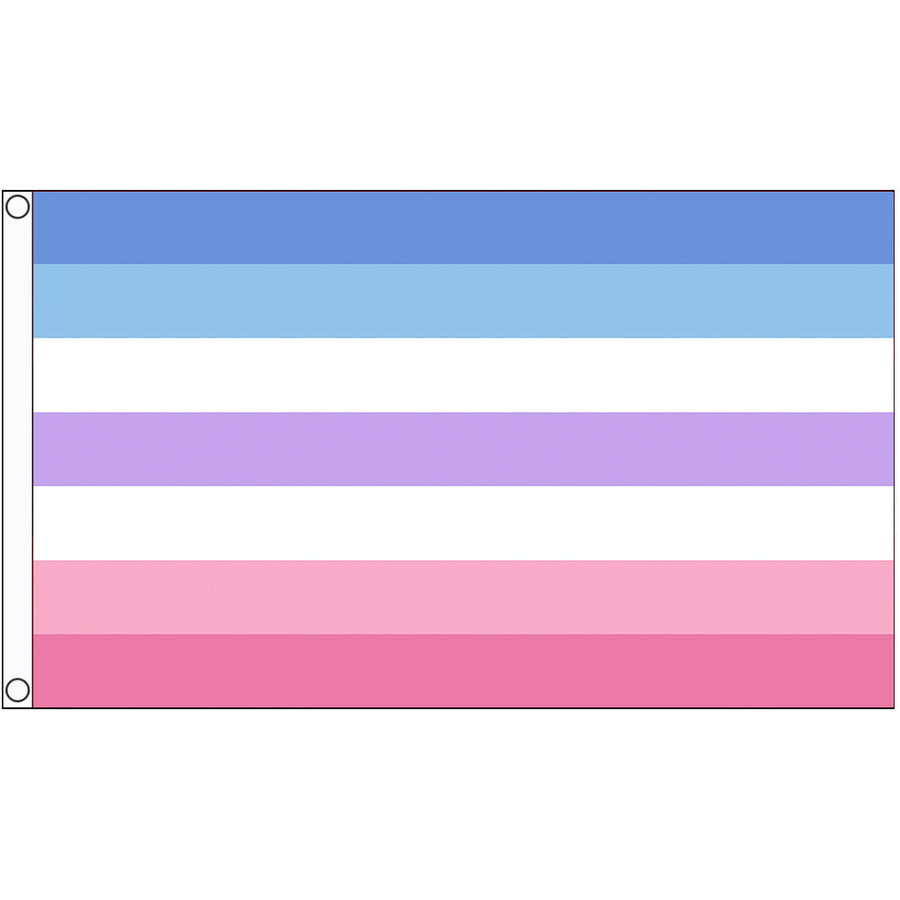
Buy on Gayprideshop
Gayprideshop offers a HQ Bigender flag!

Download the Bigender Flag.
Download as (10000×6000 px) PNG or SVG.
Can I use the downloaded flag for my personal projects? Yes you can, this flag is in the public domain and you can use it in whatever way you like.
How about commercial useage? The same, you can use it commercially and personally!
How do I know I am Bigender?
Discovering and understanding one’s gender identity, including whether you identify as bigender, is a personal and unique journey. Here are some considerations that might help you explore your feelings and experiences:
- Self-Reflection: Take time for self-reflection and consider how you feel about your gender identity. Explore your thoughts, feelings, and experiences related to gender and whether you find yourself identifying with more than one gender.
- Explore Your Feelings: Pay attention to moments when you feel a connection to different gender expressions. Reflect on any shifts or variations in your gender identity over time or in different circumstances.
- Expression and Presentation: Consider how you express your gender through clothing, appearance, and other aspects of presentation. Do you feel a sense of comfort or alignment with both masculine and feminine expressions?
- Social and Emotional Connections: Reflect on your social and emotional connections to different gender identities. Are there moments when you feel a strong connection to both masculine and feminine aspects of your identity?
- Seek Support: Connect with supportive friends, family, or community members who are knowledgeable about gender identity. Share your thoughts and feelings with them to gain additional perspectives and insights.
- Explore Gender Labels: Research and explore different gender identities, including bigender. See if the term resonates with your experiences and feelings. Keep in mind that labels are tools for self-discovery and not strict categories.
- Educate Yourself: Learn more about the experiences of individuals who identify as bigender. Reading personal stories, articles, or books about diverse gender identities can provide insights and help you contextualize your own feelings.
- Consult with Professionals: If you find the process challenging or want more guidance, consider consulting with mental health professionals, therapists, or counselors who specialize in gender identity. They can provide a supportive space for exploration.
- Embrace Fluidity: Remember that gender identity is fluid, and it’s okay if your feelings or understanding of your identity evolves over time. Embrace the journey and allow yourself the space to explore and grow.
- Connect with the Community: Engage with online or local communities that focus on gender identity and diversity. Hearing others’ experiences and sharing your own can provide a sense of belonging and understanding.
It’s important to note that everyone’s journey is unique, and there’s no universal timeline for self-discovery. Take the time you need, be patient with yourself, and trust your feelings. If at any point you feel uncertain or overwhelmed, seeking support from friends, family, or professionals can be valuable.
Recommended books
Several books explore and address the experiences of Bigender individuals, offering insights, narratives, and perspectives that can be both validating and enlightening. Here are some recommendations:
- “Stone Butch Blues” by Leslie Feinberg
This novel is a classic in LGBTQ literature and follows the life of a gender-nonconforming protagonist, exploring themes of identity and resilience.
- “Nevada” by Imogen Binnie
This novel centers around a transgender protagonist and delves into themes of self-discovery, identity, and the challenges of navigating a genderqueer existence.
- “Gender Outlaws: The Next Generation” edited by Kate Bornstein and S. Bear Bergman
This anthology features diverse voices within the LGBTQ community, including essays and narratives that encompass a wide range of gender identities and expressions. - “Genderqueer: Voices Beyond the Sexual Binary” edited by Joan Nestle, Clare Howell, and Riki Wilchins
This collection brings together personal narratives, essays, and poems that explore the experiences of genderqueer individuals, providing a rich and varied perspective. - “They/Them/Their: A Guide to Nonbinary and Genderqueer Identities” by Eris Young
A comprehensive guide that explores nonbinary and genderqueer identities, offering insights and information for those seeking to understand or navigate these experiences. - “Trans Bodies, Trans Selves” edited by Laura Erickson-Schroth
This resource covers a wide range of topics related to transgender and gender-nonconforming experiences, offering practical information and personal narratives. - “The ABC’s of LGBT+” by Ashley Mardell
Geared towards a younger audience, this book provides an accessible and informative guide to various aspects of the LGBTQ+ spectrum, including Omnisexuality. - “Trans Like Me: Conversations for All of Us” by C.N. Lester
C.N. Lester, a nonbinary activist, explores the complexities of gender identity in this thought-provoking book, combining personal experiences with broader discussions about gender. - “The Art of Being Normal” by Lisa Williamson
A fictional narrative that follows the lives of two transgender teens, this novel provides a relatable and engaging story that can resonate with individuals exploring their own identities. - “Beyond Magenta: Transgender Teens Speak Out” by Susan Kuklin
This book shares the stories of transgender and genderqueer teens, providing a platform for their voices and experiences.
These books cover a range of genres and styles, offering Bigender individuals and those seeking to understand more about gender diversity a diverse and enriching reading list. It’s essential to explore various perspectives to gain a more comprehensive understanding of the fluidity and diversity within gender identities.

Educational content and resources:
Explore the following collection of resources and websites tailored to provide valuable support and information for individuals navigating bigender identities. Whether you are seeking community connections, educational materials, or assistance in understanding and expressing your gender identity, these platforms have been curated to offer a diverse range of perspectives and resources.
- Nonbinary.org
- Offers a wealth of information on nonbinary and genderqueer identities.
- GLAAD‘s Tips for Allies of Transgender People
- Provides guidance for allies of transgender and gender nonconforming individuals.
- Gender Diversity
- Offers resources and support for families and children exploring gender identity.
- National Center for Transgender Equality (NCTE)
- Advocacy organization working towards policy reform and transgender equality.
- The Trevor Project
- A crisis intervention and suicide prevention organization for LGBTQ+ youth.
- Transgender Equality
- Provides resources, policy advocacy, and educational materials.
- Genderqueer.me
- A resource hub with articles, stories, and information on genderqueer identities.
- Autostraddle’s “Queer Your Tech”
- A tech and culture column that often includes gender-related content.
- Trans Lifeline
- A crisis hotline and resource for transgender individuals.
- PFLAG
- Offers support and resources for LGBTQ+ individuals, their families, and allies.
- Gender Diversity: Beyond the Binary
- A TED Talk playlist featuring discussions on gender diversity.
- Human Rights Campaign (HRC)
- Advocacy and educational resources for LGBTQ+ rights.
- Pronouns.org
- Offers guidance on using and respecting personal pronouns.
- National LGBTQ Task Force
- Advocacy organization working towards justice and equality for LGBTQ+ individuals.
- The Agender Project
- A platform for sharing experiences and resources related to agender identities.
- The Queer Encyclopedia
- A comprehensive resource with entries on a wide range of LGBTQ+ topics.
- Astraea Lesbian Foundation for Justice
- A foundation supporting LGBTQ+ rights globally, including gender-related issues.
Conclusion
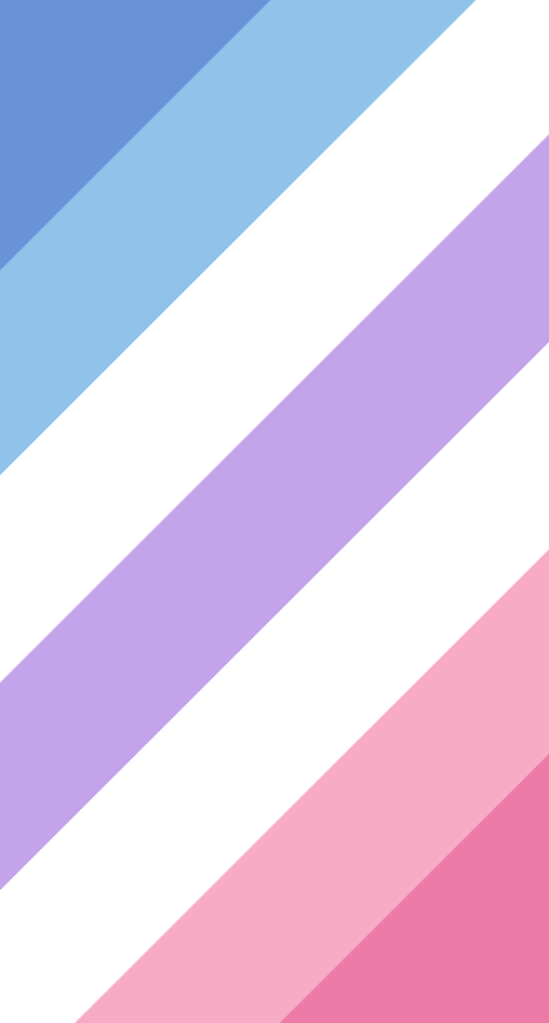
The Bigender flag is a symbolic representation of individuals who identify as bigender, experiencing two gender identities. Comprising blue, light blue, white, lavender, white, light pink, and pink, each color holds significance. Blue and pink represent binary genders, while the blending and lavender signify non-binary identities, creating a visual tapestry that celebrates the diversity and fluidity within the bigender community.

FAQs and Common Misconceptions

What does each color on the Bigender Flag represent?
The Bigender Flag consists of blue, light blue, white, lavender, white, light pink, and pink. Blue represents masculinity, pink signifies femininity, the light blue and light pink blend captures the fluidity of gender, white symbolizes non-binary identities, and lavender represents non-binary gender experiences.
Who designed the Bigender Flag, and when was it created?
The original Bigender Flag was designed by an anonymous creator. However, the flag faced controversy due to revelations about the creator. In response, alternative designs emerged, and the flag has evolved to better represent the community. The specific date of its creation is not widely documented.
How is the Bigender Flag used within the LGBTQ+ community?
The Bigender Flag is used as a symbol of visibility, recognition, and pride within the LGBTQ+ community. It is displayed during pride events, online spaces, and in various advocacy initiatives. The flag fosters awareness, acceptance, and inclusivity for individuals who identify as bigender.
Are there other related flags and symbols within the LGBTQ+ community?
Yes, the LGBTQ+ community has a range of flags and symbols representing various gender identities and sexual orientations. Examples include the transgender flag, bisexual flag, pansexual flag, and the rainbow flag, each designed to represent and celebrate different aspects of the diverse LGBTQ+ spectrum.

Can I create my own DIY version of the Bigender Flag?
Absolutely! The spirit of the LGBTQ+ community encourages personal expression. Creating your DIY Bigender Flag allows you to infuse it with your unique style, promoting a sense of individuality and connection to your identity.
What is an example of Bigender?
An example of a bigender person might be someone who identifies as both male and female, experiencing a fluidity between these genders. This individual may express their gender identity through a combination of masculine and feminine characteristics, embracing the complexity of their dual identity.
How has the Bigender Flag contributed to community acceptance and adoption?
The Bigender Flag has played a crucial role in fostering acceptance and recognition within the LGBTQ+ community. By providing a visual symbol for bigender individuals, the flag has contributed to a greater understanding of diverse gender identities, promoting inclusivity, and fostering a sense of community.
How can the Bigender Flag contribute to promoting equality and understanding?
The Bigender Flag serves as a powerful tool for education and awareness about the complexity of gender identity. By prominently featuring the flag in various settings, it helps break down stereotypes, challenges binary notions of gender, and contributes to a broader conversation about equality and understanding within society.

Are there support networks and resources available for individuals exploring their gender identity?
Yes, numerous support networks and resources exist for individuals exploring their gender identity. LGBTQ+ organizations, online communities, and mental health professionals can provide valuable guidance and support during this journey of self-discovery.
What are the different types of Bigender people?
Bigender is a diverse identity, and individuals may identify as static, fluctuating, binary, non-binary, cultural or spiritual bigender, or genderfluid bigender. These terms reflect the various ways people experience and express their dual gender identities.
What is the Bigender Flag?
The Bigender Flag is a symbol of pride and recognition for individuals who identify as bigender. It consists of blue, light blue, white, lavender, white, light pink, and pink, each color representing different aspects of the bigender experience, including masculinity, femininity, and non-binary identities.

What does the Bigender Flag mean?
The Bigender Flag symbolizes the diversity within the bigender community. Blue and pink represent the binary genders, while the blending and lavender signify non-binary identities. The flag fosters visibility, pride, and acceptance, promoting a deeper understanding of bigender experiences.
What is the role of intersectionality in the LGBT and Bigender communities?
Intersectionality recognizes the interconnectedness of various social identities, such as race, gender, and sexual orientation. In the LGBT and bigender communities, intersectionality is crucial for acknowledging and addressing the unique challenges faced by individuals who belong to multiple marginalized groups.
Are there specific pronouns I should use when referring to a Bigender person?
Pronouns vary among bigender individuals and are unique to personal preference. Some may prefer he/she, while others might use they/them or other gender-neutral pronouns. It’s essential to respect an individual’s chosen pronouns and inquire about preferences if unsure.
How does one come out as Bigender?
Coming out as bigender is a personal process. Individuals may choose to share their identity with trusted friends and family, educate those around them, or express their gender identity through personal expression. The timing and method of coming out vary, and it’s essential to prioritize one’s safety and well-being throughout the process.

How can I be a supportive ally to someone who is LGBT or Bigender?
To be a supportive ally, educate yourself about the experiences of the LGBT and bigender communities, listen to their stories, respect their identities, and use inclusive language. Be an advocate for equal rights, and offer a safe and accepting space for open conversations.
Is being transgender the same as being Bigender?
No, being transgender and bigender are distinct identities. Transgender individuals have a gender identity that differs from the sex assigned at birth, while bigender individuals identify with two gender identities, either simultaneously or at different times.
What is the difference between Bigender and non binary?
Bigender individuals identify with two genders, while non-binary individuals do not exclusively identify as male or female. Non-binary is an umbrella term encompassing various gender identities outside the binary, while bigender specifically reflects a dual gender identity.
How to tell if i am Bigender or Nonbinary?
Exploring and understanding your gender identity is a personal journey. Reflect on your feelings, experiences, and how you perceive your gender. If you feel a connection to two genders, you might identify as bigender. If you don’t exclusively identify as male or female, you might consider a non-binary identity.
What is the difference between Bigender and genderfluid?
Bigender individuals identify with two genders, which may remain constant or shift over time. Genderfluid individuals experience a dynamic and changing gender identity that may involve fluctuations between different genders. While both identities involve fluidity, they differ in the number of genders involved.
Is polysexual and Bigender the same?
No, polysexuality and bigender are distinct aspects of identity. Polysexuality refers to someone who is attracted to multiple genders but not necessarily all genders. Bigender, on the other hand, pertains to one’s gender identity, signifying the experience of identifying with two genders.




Leave a comment